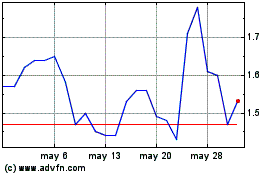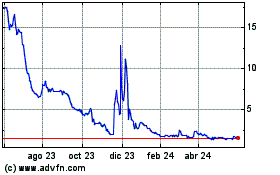- Altamira’s ability to target different KRAS mutations with a
single polyvalent siRNA sequence illustrates versatility and
potential of RNA therapeutics compared with conventional small
molecule approaches
- Analysts project global market for KRAS inhibitors to be more
than $4B by 2029
Altamira Therapeutics Ltd. (Nasdaq:CYTO), a
company developing RNA-based therapeutics that address important
unmet medical needs, today announced that it has filed a
provisional patent application with the United States Patent and
Trade Office (USPTO) to provide broad coverage of different KRAS
mutations in human cancer treatment with nanoparticles comprising
the Company’s OligoPhore™ platform and a single siRNA sequence.
The provisional patent describes novel
nanoparticle compositions based on OligoPhore, Altamira’s
peptide-based oligonucleotide delivery platform or derivatives
thereof, in combination with one siRNA (small interfering
ribonucleic acid) sequence designed to silence KRAS. In contrast to
small molecule inhibitors, that are designed to inhibit KRAS
harboring one specific mutation, Altamira’s approach, polyKRASmut,
is polyvalent as it allows for silencing KRAS carrying any of the
most abundant mutations described for this oncogene. The new filing
is intended to expand Altamira’s intellectual property related to
its AM-401 development program for the treatment of KRAS-driven
cancers.
The KRAS gene encodes the RAS protein which
controls - like an “on / off switch” – cell growth, maturation,
migration, and death. Through mutations, the RAS proteins can be
rendered persistently active, causing cancer cells to proliferate
and spread in the body. Mutations of KRAS are associated with poor
prognosis in several cancers, and there is a substantial body of
evidence supporting the role of KRAS in the initiation and
maintenance of cancer.
COO Covadonga Pañeda’s Commentary
“The ability to target different KRAS mutations
with one polyvalent siRNA sequence illustrates the great
versatility and potential of RNA therapeutics compared to classic
small molecule approaches,” stated Covadonga Pañeda, Ph.D.,
Altamira Therapeutics’ Chief Operating Officer. “In addition, the
use of siRNA is expected to elicit less treatment resistance than
the direct inhibition exerted by small molecules, which is of
particular importance in cancer treatment. However, even the most
effective RNA therapeutics are useless if they cannot be delivered
to their target, the cancer cell. By combining the polyKRASmut
siRNA with our OligoPhore technology to form the AM-401
nanoparticles, we can get it delivered precisely where it is
required. We’re excited to advance our AM-401 program to provide
clinicians and patients with a treatment option that is not limited
to just one particular KRAS mutation.”
The strategy behind AM-401 has already been
tested in vitro and in vivo where it demonstrated efficient uptake
of OligoPhore nanoparticles with KRAS-targeted siRNA in colorectal
and pancreatic cancer cells, strong inhibition of KRAS expression,
reduced viability of tumor cells, and significant reduction in
tumor growth and volume.1 Importantly, a murine model demonstrated
the capacity of the OligoPhore platform to drive targeted delivery
of the nanoparticles specifically to tumor cells. Altamira intends
to file for an Investigational New Drug (IND) application with the
FDA in late 2023.
There exist more than a dozen different KRAS
mutations, but the prevalence of mutation is exceedingly variable
among different types of cancers. Mutated forms of KRAS are found
in one-fifth of all human cancers, including 32% of non-small-cell
lung cancers (NSCLCs), 40% of colorectal cancers (CRCs) and 85–90%
of pancreatic cancers. According to the American Cancer Society,
overall, almost 150,000 new cases of KRAS-mutated tumors are
diagnosed in the United States alone across just these three tumors
types each year. It has been estimated that mutations in KRAS alone
account for approximately one million deaths per year
worldwide.2 Analysts project the global market for KRAS
inhibitors to grow from virtually zero in 2021 to more than $4
billion by 2029.3
Although the role of KRAS mutations in cancer
has been known for decades, they have remained a challenging target
for therapeutic interventions. KRAS was long considered
undruggable, in part, because of the lack of obvious binding sites.
Only recently, the FDA approved the first two treatments for
KRAS-driven cancer: sotorasib and adagrasib, two small molecule
inhibitors of G12C-mutated KRAS for the treatment of NSCLC.
About OligoPhore™
OligoPhore is a versatile platform designed to
enable safe and effective delivery of oligonucleotides such as
siRNA (small interfering ribonucleic acid) into target cells, using
systemic or local administration. It is based on a proprietary 21
amino acid peptide that can engage any type of RNA, including mRNA,
in rapid self-assembly into a polyplex. The polyplex has a size,
charge, and other physical features that allow it to escape hepatic
clearance and thus to reach target tissues other than the liver.
OligoPhore protects the RNA payload from degradation in the
circulation and allows for rapid cellular uptake, while enabling
pH-dependent nucleotide full endosomal escape and cytoplasmic
delivery. Effective delivery and positive treatment outcomes have
been demonstrated in more than ten diverse murine models of disease
for cancer, cardiovascular, and rheumatological targets in the
NF-κB family, various members of the ETS transcription factor
family, and targets in the JNK and TAM pathways.
About Altamira Therapeutics
Altamira Therapeutics (NASDAQ:CYTO) is dedicated
to developing RNA-based therapeutics for extrahepatic targets
(OligoPhore™ / SemaPhore™ delivery platforms). The Company
currently has two flagship siRNA programs in preclinical
development beyond in vivo proof of concept: AM-401 for KRAS driven
cancer and AM-411 for rheumatoid arthritis. The versatile delivery
platform is also suited for mRNA and other types of RNA
therapeutics and is planned to be leveraged via out-licensing to
pharma or biotech companies.
In addition, Altamira is in the process of
divesting and/or out-licensing its legacy assets in allergology and
viral infection with its Bentrio® OTC nasal spray (commercial
stage); and with inner ear therapeutics drugs AM-125 nasal spray
for vertigo (post Phase 2), and Keyzilen® and Sonsuvi® for tinnitus
and hearing loss, (Phase 3). Founded in 2003, Altamira is
headquartered in Hamilton, Bermuda, with its main operations in
Basel, Switzerland. For more information, visit:
https://altamiratherapeutics.com/
Forward-Looking Statements
This press release may contain statements that
constitute "forward-looking statements" within the meaning of
Section 27A of the Securities Act of 1933 and Section 21E of the
Securities Exchange Act of 1934. Forward-looking statements are
statements other than historical facts and may include statements
that address future operating, financial or business performance or
Altamira Therapeutics' strategies or expectations. In some cases,
you can identify these statements by forward-looking words such as
"may", "might", "will", "should", "expects", "plans",
"anticipates", "believes", "estimates", "predicts", "projects",
"potential", "outlook" or "continue", or the negative of these
terms or other comparable terminology. Forward-looking statements
are based on management's current expectations and beliefs and
involve significant risks and uncertainties that could cause actual
results, developments and business decisions to differ materially
from those contemplated by these statements. These risks and
uncertainties include, but are not limited to, the success of the
continued commercialization of Bentrio and success of strategic
transactions, including licensing or partnering, with respect to
Bentrio or any other legacy assets, Altamira Therapeutics' need for
and ability to raise substantial additional funding to continue the
development of its product candidates, the timing and conduct of
clinical trials of Altamira Therapeutics' product candidates, the
clinical utility of Altamira Therapeutics' product candidates, the
timing or likelihood of regulatory filings and approvals, Altamira
Therapeutics' intellectual property position and Altamira
Therapeutics' financial position, including the impact of any
future acquisitions, dispositions, partnerships, license
transactions or changes to Altamira Therapeutics' capital
structure, including future securities offerings. These risks and
uncertainties also include, but are not limited to, those described
under the caption "Risk Factors" in Altamira Therapeutics' Annual
Report on Form 20-F for the year ended December 31, 2021, and in
Altamira Therapeutics' other filings with the SEC, which are
available free of charge on the Securities Exchange Commission's
website at: www.sec.gov . Should one or more of these risks or
uncertainties materialize, or should underlying assumptions prove
incorrect, actual results may vary materially from those indicated.
All forward-looking statements and all subsequent written and oral
forward-looking statements attributable to Altamira Therapeutics or
to persons acting on behalf of Altamira Therapeutics are expressly
qualified in their entirety by reference to these risks and
uncertainties. You should not place undue reliance on
forward-looking statements. Forward-looking statements speak only
as of the date they are made, and Altamira Therapeutics does not
undertake any obligation to update them in light of new
information, future developments or otherwise, except as may be
required under applicable law.
hear@altamiratherapeutics.com
800-460-0183
Altamira Therapeutics (NASDAQ:CYTO)
Gráfica de Acción Histórica
De Dic 2024 a Ene 2025

Altamira Therapeutics (NASDAQ:CYTO)
Gráfica de Acción Histórica
De Ene 2024 a Ene 2025
